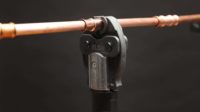The University of Cincinnati, founded in the early 1800s, is a public research university serving over 47,000 undergraduate and graduate students on a 200-plus-acre campus. It also operates two central utility plants that serve the campus plus multiple local hospitals.
Like many universities across America, the University of Cincinnati, or UC, faced a major infrastructure challenge: having to operate aging central utility plants with older technology, reduced efficiencies and capacities, with chilled water equipment at the end of its service life. UC’s overall strategy was to develop a multi-year utility plant modernization program, with goals including increased efficiency, reduced peak electric demand, and more operational flexibility, including the ability to operate chillers at low loads.
To replace their aging 5,200-ton unit, the university ordered the first two of three Advanced Technology 2,400-ton Magnetic Bearing V Class Chillers from Smardt Chiller Group, maker of oil-free, magnetic-bearing centrifugal chillers. The need was particularly urgent because of the six hospitals and research centers that the university’s chiller fleet supplies chilled water for via a campus HVAC system. The university must be able to deliver reliable utilities every day, all day, while maintaining a 99.9% energy reliability rating. Any drop in capacity could affect the comfort and well-being of patients and personnel.
On top of that, University of Cincinnati also faced the annual summer electric distribution ratchet tariff — a surcharge that potentially boosts energy costs for the University from June 1 through September 30. If the new chiller wasn’t in place, UC could face significant charges.
The first chiller arrived onsite in May 2019 and went into operation two days later — a day before tariff season began. The second chiller was installed that July.
Following their installation, UC purchased a third Smardt V Class 2,400-ton chiller and installed it in 2020, replacing a 28-year-old unit. Now fully in service, the three new chillers — which were painted crimson red and black in a show of school pride — represent about 15% of the campus chiller capacity while delivering significant energy savings over the previous units.
The primary energy savings come from six Danfoss Turbocor VTT compressors used in each chiller, which operate on varying load conditions. Savings are achieved by running several compressors simultaneously at a lower load, rather than one or two compressors at maximum capacity. The oil-free, magnetic bearing technology eliminates complex oil and refrigerant lubrication management systems, resulting in a simplified chiller design and reduced maintenance. Additional energy efficiency is generated by using a sequenced compressor startup, which uses variable-speed functionality to match load demand.
By the two-year mark, which included the startup of the third chiller, the university saw a 32% reduction in operating costs and a sustained decrease in campus electric demand. According to estimates, by 2030 the university can expect:
- A total KWhr reduction of 56 million, 36 million of which is attributed to the Smardt chillers
- Energy cost reductions of $2.15 million, over half of which is attributed to Smardt
- Maintenance cost reduction: $216,000
- And return on investment within four years of each chiller’s startup.
Along with reduced energy costs, the new chillers reduced the University’s CO2 output by 1,991 tons per year.







